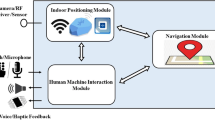Abstract
Overlapped FFT has been proposed as a signal detection scheme in dynamic spectrum access to reduce the variance of the noise and improve the detection probability. However, the improvement of the detection probability in the conventional overlapped FFT is bounded with the upper limit of the overlap ratio. This paper proposes a new overlapped FFT scheme using additional frames. In the proposed scheme, in addition to the original FFT frames, new frames that consist of multiple subframes with non-continuous samples are constructed and included. It can realize the increase of the number of the FFT frames and the improvement of the detection probability compared with the conventional scheme. Numerical results through computer simulation show that the proposed scheme improves the detection probability by up to 0.07. On indoor channel models the proposed scheme also improves the detection probability. In addition, it is clarified that as the delay spread increases the detection probability reduces due to the correlation between the frames.













Similar content being viewed by others
References
Mitra III, J., & Maguire Jr, G. Q. (1999). Cognitive radio: Making software radios more personal. IEEE Personal Communications, 6(4), 13–18.
Mitra III, J. ( 1999). Cognitive radio for flexible mobile multimedia communications. In 1999 IEEE international workshop on mobile multimedia communications (pp. 3–10).
Haykin, S. (2005). Cognitive radio: Brain-empowered wireless communications. IEEE Journal on Selected Areas in Communications, 23(2), 201–220.
Yücek, T., & Arslan, H. (2009). A survey of spectrum sensing algorithms for cognitive radio applications. IEEE Communications Surveys & Tutorials, 11(1), 116–130.
Zhao, Q., & Sadler, B. M. (2007). A survey of dynamic spectrum access. IEEE Signal Processing Magazine, 24(3), 79–89.
IEEE Std. 1900.6–2011. (2011). IEEE standard for spectrum sensing interfaces and data structures for dynamic spectrum access and other advanced radio communication systems.
Macaluso, I., Forde, T. K., DaSilva, L., & Doyle, L. (2012). Impact of cognitive radio: Recognition and informed exploitation of grey spectrum opportunities. IEEE Vehicular Technology Magazine, 7(2), 85–90.
Hu, Z., Sun, Y., & Ji, Y. (2011). A dynamic spectrum access strategy based on real-time usability in cognitive radio sensor networks. In Seventh international conference on mobile ad-hoc and sensor networks (MSN).
Matsudo, T., Utsunoiya, M., Tanaka, M., Nakano, K., & Maruta, R. (2012.). Experiments of receiving TV white space and another frequency band by trying to apply cisco cleanair technology implementing cognitive radio technology for wireless LAN frequency bands—considering IEEE802.11 af Draft . In 565th URSI Commission F Meeting.
Maranda, B. H. (1996). On the false alarm probability for an overlapped FFT processor. IEEE Transaction on Aerospace and Electronic System, 32(4), 1452–1456.
Fan, H., Wang, S., Chen, F., & Zhu, Y. (2006). Frame-overlapped zoom-FFT optimization in PD radar application. In International conference on radar (pp. 1–5).
Wang, S., Inkol, R., Rajan, S., & Patenaude, F. (2010). Detection of narrow-band signals through the FFT and polyphase FFT filter banks: Noncoherent versus coherent integration. IEEE Transaction on Instrumentation and Measurement, 59(5), 1424–1438.
Tomioka, T., Tomizawa, T., & Kobayashi, T. (2009). High-sensitivity carrier sensing using overlapped FFT for cognitive radio transceivers. In IEEE 69th vehicular technology conference.
Takai, R., Uchida, S., Sato, A., & Sanada, Y. (2014). Experimental investigation of signal sensing with overlapped FFT based energy detection. Wireless Personal Communications 77(1), 553–569.
Proakis, J. (1989). Digital Communications (2nd ed.). New York: McGraw-Hill.
Golub, G. H., & Van Loan, C. F. (1996). Matrix Computations (3rd ed.). Baltimore: The Johns Hopkins University Press.
Joint Technical Committee of Committee T1 R1P1.4 and TIATR46.3.3/TR45.4.4 on Wireless Access (1994). Draft Final Report on RF Channel Characterization, Paper No. JTC(AIR)/94. 01. 17–238R4.
IEEE Std. 802.22–2011. (2011). IEEE 802.22-Part 22: Cognitive wireless RAN medium access control (MAC) and physical layer (PHY) specifications: Policies and procedures for operation in the TV bands.
Chong, J. W., Sung, Y., & Sung, D. K. (2008). Cross-layer performance analysis for CSMA/CA systems: Impact of imperfect sensing. In SPAWC 2008.
Tandra, R., & Sahai, A. (2008). SNR walls for signal detection. IEEE Journal on Selected Topics in Signal Processing, 2(1), 4–17.
Author information
Authors and Affiliations
Corresponding author
Rights and permissions
About this article
Cite this article
Uchida, S., Sato, A., Inamori, M. et al. Signal Detection Performance of Overlapped FFT Scheme with Additional Frames Consisting of Non-continuous Samples in Indoor Environment. Wireless Pers Commun 79, 987–1002 (2014). https://doi.org/10.1007/s11277-014-1899-4
Published:
Issue Date:
DOI: https://doi.org/10.1007/s11277-014-1899-4




